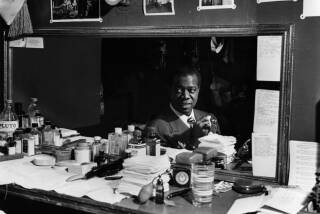JAZZ REVIEW : Tribute to Trumpeter-Composer Rogers a Nostalgic Triumph
- Share via
Nostalgia is what it used to be. Friday’s tribute to Shorty Rogers, produced and emceed by Ken Poston for KLON-FM and presented at the Hermosa Civic Theater, was sold out weeks in advance and drew a crowd liberally sprinkled with fans for whom the trumpeter-composer symbolizes an era in West Coast jazz.
Rogers himself did not take part, except to join briefly with Terry Gibbs and Chubby Jackson in the scat vocal on “Lemon Drop” and to receive a salutation from Councilman Michael Woo. For the most part he sat in the audience beaming while Poston took the honoree smoothly through a “This Is Your Life.”
Ironically, the evening’s top honors went to the only artist who didn’t play any Rogers tunes. Stan Getz, paying eloquent verbal tribute to Rogers, conjured sheer beauty out of “Suddenly It’s Spring,” “A Handful of Stars” and a bossa nova, “The Dolphin.” Nobody could top those blissful minutes, but some came close.
Mark Masters led a 15-piece group that served as a house band, simulating the sounds of the groups in which Rogers had played: Woody Herman, the Lighthouse All Stars, the Shorty Rogers Giants and, of course, Stan Canton (for this segment Masters added 14 young string players recruited from Long Beach State).
Rogers’ versatility as a composer was represented by everything from a witty blues riff piece (“Martians Come Home”), played by the Lighthouse group, to an alto sax concerto originally written for and entitled “Art Pepper,” brought vividly to new life by Gabe Baltazar. The strings were used here, and again in “Coop’s Solo,” composed for Bob Cooper, who later shared space with fellow saxophonist Bud Shank and Bill Perkins in the Lighthouse set, along with trumpeter Conte Candoli.
Several film clips were shown, supplied by archivist Mark Cantor, but the first one was mangled through misthreading and the others were seldom in focus (a D-minus for the projectionist). Still, it was intriguing to see these glimpses of the young black-haired jazzman who later appeared on stage, white-haired but musically stronger than ever.
With Lou Levy or Pete Jolly on piano, Monty Budwig on bass and Paul Humphrey on drums, the music swung buoyantly. Spelling the musicians were producers who played a role in Rogers’ evolution: Gene Norman, Jack Lewis, Howard Rumsey and Bobby Troup (who introduced a rare clip from his 1958 “Stars of Jazz” TV series). Their recollections were affectionate rather than affected, often diverting and never dreary.
If it proved nothing else, this well-organized evening left no doubt that the California jazz sounds of the 1950s, so often maligned as too cool or as vanilla music, had a validity that has survived unscarred by the inroads of time.
More to Read
The biggest entertainment stories
Get our big stories about Hollywood, film, television, music, arts, culture and more right in your inbox as soon as they publish.
You may occasionally receive promotional content from the Los Angeles Times.










